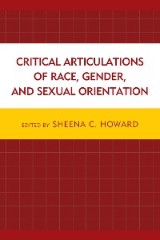Details

Critical Articulations of Race, Gender, and Sexual Orientation
|
57,99 € |
|
| Verlag: | Lexington Books |
| Format: | EPUB |
| Veröffentl.: | 17.09.2014 |
| ISBN/EAN: | 9780739199176 |
| Sprache: | englisch |
| Anzahl Seiten: | 296 |
DRM-geschütztes eBook, Sie benötigen z.B. Adobe Digital Editions und eine Adobe ID zum Lesen.
Beschreibungen
<span><span>Critical Articulations of Race, Gender, and Sexual Orientation </span><span>engages scholarly essays, poems, and creative writings that examine the meanings of race, gender, and sexual orientation as interlocking systems of oppression. Each chapter in this volume critically, yet creatively, interrogates the notion of identity as socially constructed, yet interconnected and shaped by cultural associations, expanding on the idea that we as individuals live in an </span><span>identity matrix—</span><span>our self-concept, experiences, and interpretations originate or are developed from the culture in which we are embedded. The shaping of an individual’s identity, communication, and worldview can be read, shaped, and understood through life, art, popular culture, mass media, and cross-cultural interactions, among other things. The aptness of this work lies in its ability to provide a meaningful and creative space to analyze identity and identity politics, highlighting the complexities of identity formation in the twenty-first century.</span></span>
<span><span>This collection features engaging scholarly essays and creative writings that examine the meaning of race, gender, and sexual orientation as interlocking systems of oppression. It provides a meaningful space to analyze identity and identity politics, highlighting the complexities of identity formation in the twenty-first century.</span></span>
<span><span>Introduction, </span><span>Sheena C. Howard</span></span>
<br>
<span></span>
<br>
<span><span>“In Teaching Persona”, </span><span>Shelly Bell</span></span>
<br>
<span></span>
<br>
<span><span>Part I: Queer Identity Matrix</span></span>
<br>
<span><span>Chapter 1: Coming In/Out of the Closet: Living In-Between Singlehood and Relationship(s) through a Gay Asian Body, </span><span>Shinsuke Eguchi</span></span>
<br>
<span><span>Chapter 2: Divided Loyalties: Exploring the Intersections of Queerness, Race, Ethnicity, and Gender, </span><span>Richard G. Jones, Jr.</span></span>
<br>
<span><span>Chapter 3: Young Black and Latino Gay Men’s Experiences with Racial Microaggressions, </span><span>Lourdes D. Follins</span></span>
<br>
<span><span>Chapter 4: Organizing Foreignness: Of Aliens, Permanence, and Shape-Shifters, </span><span>Rahul Mitra</span></span>
<br>
<span></span>
<br>
<span><span>“The Origin of Coming Out”, </span><span>Shelly Bell</span></span>
<br>
<span></span>
<br>
<span><span>Part II: Identity Formation</span></span>
<br>
<span><span>Chapter 5: Latinas in the United States: Articulating Discourses of Identity and Difference, </span><span>Claudia Bucciferro</span></span>
<br>
<span><span>Chapter 6: Me and My Shadow(s): Essays of Self and Identity, </span><span>Brad Crownover</span></span>
<br>
<span><span>Chapter 7: Reliving Oppression: Becoming Black, Becoming Gay, </span><span>Godfried Asante and Myra N. Roberts</span></span>
<br>
<span><span>Chapter 8: Coming Out, Covering, Connecting: De/Colonizing Epistemics of Ethnography and Ethnographer Positionality in Malaysia, </span><span>Cheryl L. Nicholas</span></span>
<br>
<span></span>
<br>
<span><span>“What Truth?”, </span><span>Shelly Bell</span></span>
<br>
<span></span>
<br>
<span><span>Part III: Mass Mediated Representations</span></span>
<br>
<span><span>Chapter 9: Trans*ing Priestly Performances: Re-Reading Gender Potentiality in Erdrich’s </span><span>The Last Report on the Miracles at Little No Horse, Benjamin LeMaster and Meggie Mapes</span></span>
<br>
<span><span>Chapter 10: Marking My Black Feminist Heterosexism: Taking Autoethnographic Notes from </span><span>Pariah, Rachel Alicia Griffin</span></span>
<br>
<span><span>Chapter 11: Heterosexual Masculinity, the Self, and Social Needs: The Homicidal Hazing of Robert Champion, </span><span>Michele K. Lewis</span></span>
<br>
<span><span>Chapter 12: A Multimodal Critical Discourse Analysis (MCDA) of Race, Class, Gender, and Sexual Orientation within the YouTube-based "It Gets Better Project", </span><span>Laurie Phillips Honda</span></span>
<br>
<span><span>Chapter 13: "Don</span><span>’</span><span>t Even Go There!" A Black Women</span><span>’</span><span>s Standpoint and Conversation Analysis of an Online Discussion about Racial Labeling, </span><span>Darlene K. Drummond and Sakile Kai Camara</span></span>
<br>
<span><span>Chapter 14: Friends of </span><span>Batman</span><span> (And Dorothy): Queering the </span><span>Green Hornet</span><span> Television Series, </span><span>Bruce E. Drushel</span></span>
<br>
<span></span>
<br>
<span><span>“In Teaching Persona”, </span><span>Shelly Bell</span></span>
<br>
<span></span>
<br>
<span><span>Part I: Queer Identity Matrix</span></span>
<br>
<span><span>Chapter 1: Coming In/Out of the Closet: Living In-Between Singlehood and Relationship(s) through a Gay Asian Body, </span><span>Shinsuke Eguchi</span></span>
<br>
<span><span>Chapter 2: Divided Loyalties: Exploring the Intersections of Queerness, Race, Ethnicity, and Gender, </span><span>Richard G. Jones, Jr.</span></span>
<br>
<span><span>Chapter 3: Young Black and Latino Gay Men’s Experiences with Racial Microaggressions, </span><span>Lourdes D. Follins</span></span>
<br>
<span><span>Chapter 4: Organizing Foreignness: Of Aliens, Permanence, and Shape-Shifters, </span><span>Rahul Mitra</span></span>
<br>
<span></span>
<br>
<span><span>“The Origin of Coming Out”, </span><span>Shelly Bell</span></span>
<br>
<span></span>
<br>
<span><span>Part II: Identity Formation</span></span>
<br>
<span><span>Chapter 5: Latinas in the United States: Articulating Discourses of Identity and Difference, </span><span>Claudia Bucciferro</span></span>
<br>
<span><span>Chapter 6: Me and My Shadow(s): Essays of Self and Identity, </span><span>Brad Crownover</span></span>
<br>
<span><span>Chapter 7: Reliving Oppression: Becoming Black, Becoming Gay, </span><span>Godfried Asante and Myra N. Roberts</span></span>
<br>
<span><span>Chapter 8: Coming Out, Covering, Connecting: De/Colonizing Epistemics of Ethnography and Ethnographer Positionality in Malaysia, </span><span>Cheryl L. Nicholas</span></span>
<br>
<span></span>
<br>
<span><span>“What Truth?”, </span><span>Shelly Bell</span></span>
<br>
<span></span>
<br>
<span><span>Part III: Mass Mediated Representations</span></span>
<br>
<span><span>Chapter 9: Trans*ing Priestly Performances: Re-Reading Gender Potentiality in Erdrich’s </span><span>The Last Report on the Miracles at Little No Horse, Benjamin LeMaster and Meggie Mapes</span></span>
<br>
<span><span>Chapter 10: Marking My Black Feminist Heterosexism: Taking Autoethnographic Notes from </span><span>Pariah, Rachel Alicia Griffin</span></span>
<br>
<span><span>Chapter 11: Heterosexual Masculinity, the Self, and Social Needs: The Homicidal Hazing of Robert Champion, </span><span>Michele K. Lewis</span></span>
<br>
<span><span>Chapter 12: A Multimodal Critical Discourse Analysis (MCDA) of Race, Class, Gender, and Sexual Orientation within the YouTube-based "It Gets Better Project", </span><span>Laurie Phillips Honda</span></span>
<br>
<span><span>Chapter 13: "Don</span><span>’</span><span>t Even Go There!" A Black Women</span><span>’</span><span>s Standpoint and Conversation Analysis of an Online Discussion about Racial Labeling, </span><span>Darlene K. Drummond and Sakile Kai Camara</span></span>
<br>
<span><span>Chapter 14: Friends of </span><span>Batman</span><span> (And Dorothy): Queering the </span><span>Green Hornet</span><span> Television Series, </span><span>Bruce E. Drushel</span></span>
<span><span>Sheena C. Howard </span><span>is assistant professor in the Department of Communication and Journalism at Rider University.</span></span>


















